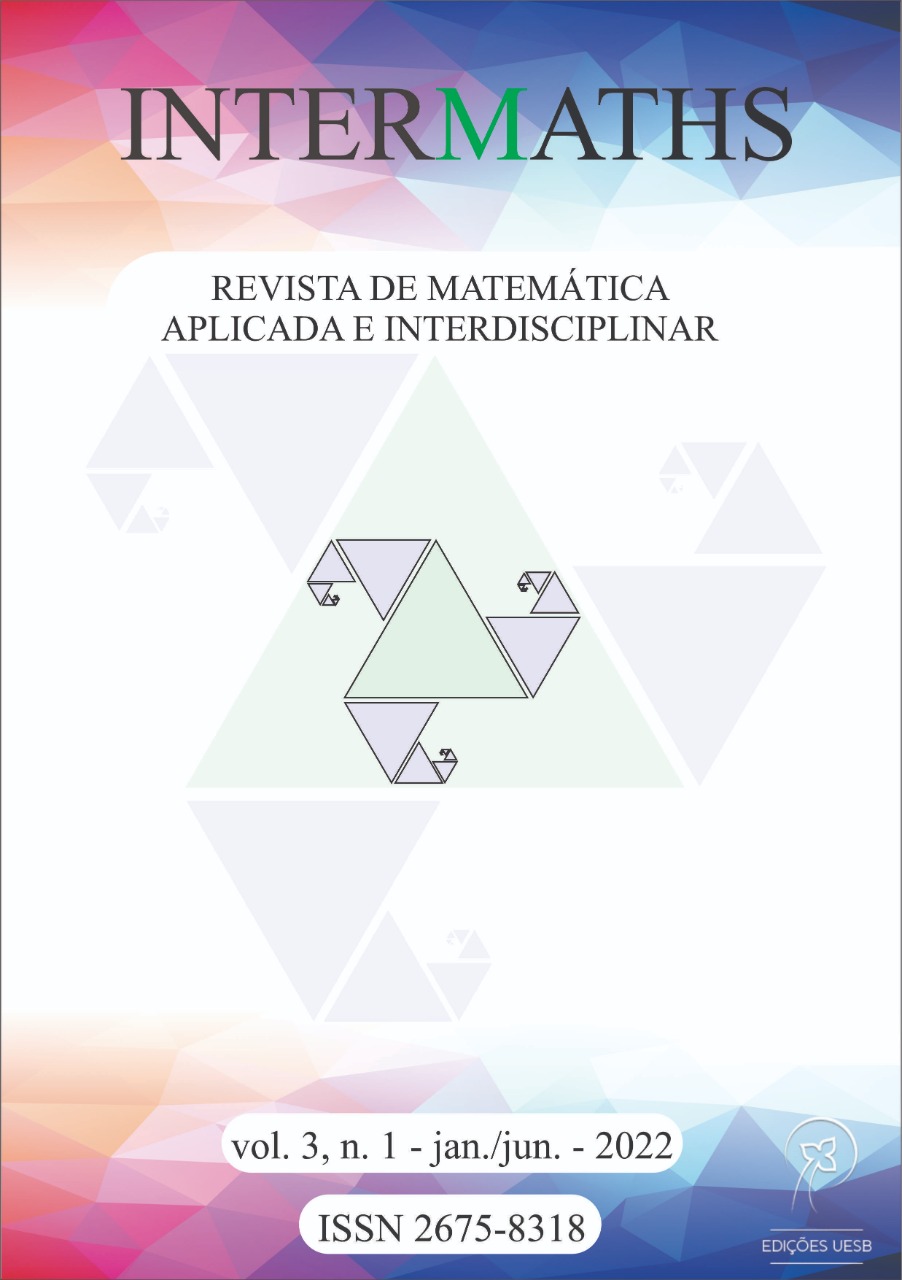Um Modelo Matemático Discreto do tipo SIR aplicado à dados de casos da COVID-19 no Estado de Mato Grosso
DOI:
https://doi.org/10.22481/intermaths.v3i1.10279Palavras-chave:
Modelagem Matemática, Simulações Numéricas, Modelo Matemático Discreto, Método dos Mínimos QuadradosResumo
Neste artigo apresentamos um modelo matemático discreto do tipo SIR em que são utilizados dados relativos ao número de casos da COVID-19 no Estado de Mato Grosso, Brasil, para elaborar simulações e previsões sobre o fenômeno de propagação da doença. Os parâmetros do modelo foram estimados por meio de dados presentes na literatura científica e também por meio do método de ajuste por mínimos quadrados. Dentre as simulações presentes neste trabalho, destacam-se àquelas que estimam o impacto da adesão, ou não, da população às medidas de distanciamento social e do uso de máscaras. Um dos resultados mostra que se 70\% da população aderisse a ambas medidas, teríamos a extinção do contágio em poucos meses. Esta pesquisa teve caráter exploratório e seus resultados servem apenas de indicativos não possuindo um caráter conclusivo.
Downloads
Referências
[1] SES, Secretaria de Estado de Saúde de Mato Grosso, “Painel Informativo COVID-19,” 2021. http://www.saude.mt.gov.br/painelcovidmt2/ Acesso em: 09/05/2021.
[2] W. Kermack, A. McKendrick, “A contribution to the mathematical theory of epidemics,” in Proceedings of the Royal Society of London, Series A, Mathematical and Physical Sciences, vol. 115, no. 772, pp. 700-721, 1927.
[3] O. Diekmann, J. A. P. Heesterbeek. Mathematical Epidemiology of infectious diseases: model building, analysis and interpretatiton, England, John Wiley and Sons Ltda, 2000.
[4] Z. Ma, “Some Recent Results on Epidemic Dynamics Obtained by Our Group,” in Modeling and Dynamics of Infectious Diseases, Z. Ma, Y. Zhou and J. Wu, Eds. Series in Contemporary Applied Mathematics, Vol. 11. Beijing and World Scientific; Singapore: Higher Ed. Press, 2009; pp. 1–35.https://doi.org/10.1142/9789814261265_0001
[5] T. Sitthiwirattham, A. Zeb, S. Chasreechai, Z. Eskandari, M. Tilioula and S. Djilali, “Analysis of a discrete mathematical COVID-19 model,” Results in Physics, vol. 28, p. 104668, 2021. https://doi.org/10.1016/j.rinp.2021.104668
[6] L. M. E. Assis, A. Mendonça and R. A. Assis, “Ajuste de curvas utilizando dados do coronavírus COVID-19 e sistemas dinâmicos discretos,” Biomatemática, vol. 30, pp. 93-110, 2020.
[7] P. R. Zingano. et al. Observações sobre previsões da evolução da COVID-19 por modelos matemáticos. Instituto de Matemática e Estatística, Universidade Federal do Rio Grande do Sul, 2020. https://www.ufrgs.br/ime/wp-content/uploads/2020/04/Evolu%C3%A7%C3%A3o_da_Covid1-1.pdf
[8] T. A. Mellan, H. H Hoeltgebaum, S. Mishra, C. Whittaker, R. P Schnekenberg, A. Gandy, H. J. T.Unwin, M. A. C. Vollmer, H. Coupland, I. Hawryluk, N. R. Faria, J. Vesga, H. Zhu, M. Hutchinson, O. Ratmann, M. Monod, K. Ainslie, M. Baguelin, S. Bhatia, A. Boonyasiri, N. Brazeau, G. Charles, L.V. Cooper, Z. Cucunuba, G. Cuomo-Dannenburg, A. Dighe, B. Djaafara, J. Eaton, S. L. van Elsland, R. FitzJohn, K. Fraser, K. Gaythorpe, W. Green, S. Hayes, N. Imai, B. Jeffrey, E. Knock, D. Laydon, J. Lees, T. Mangal, A. Mousa, G. Nedjati-Gilani, P. Nouvellet, D. Olivera, K. V. Parag, M. Pickles, H. A. Thompson, R. Verity, C. Walters, H. Wang, Y. Wang, O. J. Watson, L. Whittles, X. Xi, L. Okell, I. Dorigatti, P. Walker, A. Ghani, S. Riley, N. M Ferguson, C. A. Donnelly, S. Flaxman and S. Bhatt, Estimating COVID-19 cases and reproduction number in Brazil, Report 21, Imperial College London, May/2020. :https://doi.org/10.25561/78872
[9] A. El Bhih, Y. Benfatah, A. Kouidere and M. Rachik, “A discrete mathematical modeling of transmission of COVID-19 pandemic using optimal control,” Communications in Mathematical Biology and Neuroscience, 2020, Artigo ID 75. https://doi.org/10.28919/cmbn/4780
[10] G. B. Almeida, “Aplicação de modelos matemáticos em pandemias: um estudo de comportamento epidemiológico a partir da Covid-19,” Tese de doutorado do Programa de Pós-Graduação em Doenças Tropicais, Faculdade de Medicina de Botucatu, Universidade Estadual Paulista Júlio Mesquita Filho, 2022.
[11] CDC, Centers for Disease Control and Prevention, “Interim Guidance on Ending Isolation and Precautions for Adults with COVID-19,” 2021. https://www.cdc.gov/coronavirus/2019-ncov/hcp/duration-isolation.html#print Acesso em: 24/04/2021.
[12] S.F. Lumley, D. O’Donnell, N.E. Stoesser, P.C. Matthews, A. Howarth, S.B. Hatch, B.D. Marsden, S. Cox, T. James, F. Warren, L.J. Peck, T.G. Ritter, Z. de Toledo, L. Warren, D. Axten, R.J. Cornall, E.Y. Jones, D.I. Stuart, G. Screaton, D. Ebner, S. Hoosdally, M. Chand, D.W. Crook, A.-M. O’Donnell, C.P. Conlon, K.B. Pouwels, A.S. Walker, T.E.A. Peto, S. Hopkins, T.M. Walker, K. Jeffery, and D.W. Eyre, “Antibody status and incidence of SARS-CoV-2 infection in health care workers,” New England Journal of Medicine, vol. 384, no. 6, pp. 533-540, 2021. http://dx.doi.org/10.1056/NEJMoa2034545
[13] D. Cromer, J. A. Juno, D. Khoury, A. Reynaldi, A. K. Wheatley, S. J. Kent and M. P. Davenport, “Prospects for durable immune control of SARS-CoV-2 and prevention of reinfection,” vol. 21, no. 6, pp. 395-404, 2021. https://doi.org/10.1038/s41577-021-00550-x
[14] A. L. Nogueira, C. L. Nogueira, A. W. Zibetti, N. Roqueiro, O. Bruna-Romero and B. A. M. Carciofi, “Estimativa da subnotificação de casos da covid-19 no estado de Santa Catarina,” Notícias UFSC, Florianópolis, 2020. Disponível em: https://noticias.paginas.ufsc.br/files/2020/05/aqui.pdf
[15] IBGE, Instituto Brasileiro de Geografia e Estatística , “Cidades Panorama,” 2021. https://cidades.ibge. gov.br/brasil/mt/panorama Acesso em: 03/01/2021.
[16] M. B. Prado, B. B. P. Antunes, L. S. L. Bastos, I. T. Peres, A. A. B. da Silva, L. F. Dantas, F. A. Baião, P. Maçaira, S. Hamacher and F. A. Bozza, “Análise da subnotificação de COVID-19 no Brasil,” Revista Brasileira de Terapia Intensiva (online), 2020. https://doi.org/10.5935/0103-507X.20200030
[17] J. A. Azevedo, “Um modelo matemático discreto do tipo SIR aplicado à COVID-19 e considerações sobre o uso da Modelagem Matemática no Ensino Médio,” Dissertação de Mestrado do Programa de Pós-Graduação Profissional em Matemática - PROFMAT, Matemática, Universidade Estadual de Mato Grosso, 2021.
[18] P. A. Morettin, W. O. Bussab. Estatística básica, Saraiva Educação SA, São Paulo, 2004.
[19] J.-M. Wendling, T. Fabacher, P.-P. Pébaÿ, I. Cosperec, and M. Rochoy, “Experimental efficacy of the face shield and the mask against emitted and potentially received particles,” International Journal of Environmental Research and Public Health, vol. 18, no. 4, p. 1942, 2021. https://doi.org/10.3390/ijerph18041942
[20] M. R. Gonçalves, R. C. P. dos Reis, R. P. Tólio, L. C. Pellanda, M. I. Schmidt, N. Katz, S. S. Mengue, P. C. Hallal, B. Lessa Horta, M. F. Silveira, R. N. Umpierre, C. G. Bastos-Molina, R. S. da Silva and B. B. Duncan, “Social Distancing, Mask Use and the Transmission of SARS-CoV-2: A Population-Based Case-Control Study,” SSRN - Preprints with Lancet, 2020. https://dx.doi.org/10.2139/ssrn.3731445
Downloads
Publicado
Como Citar
Edição
Seção
Licença
Copyright (c) 2022 INTERMATHS

Este trabalho está licenciado sob uma licença Creative Commons Attribution 4.0 International License.
 All content of Revista INTERMATHS/Journal INTERMATHS is licensed under a Creative Commons - Atribuição 4.0 Internacional (CC-BY 4.0).
All content of Revista INTERMATHS/Journal INTERMATHS is licensed under a Creative Commons - Atribuição 4.0 Internacional (CC-BY 4.0).












